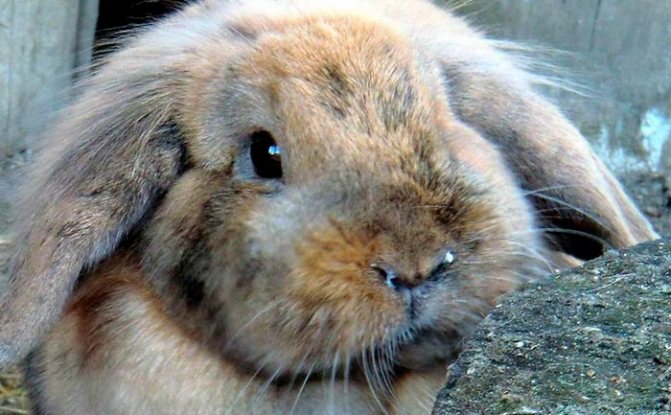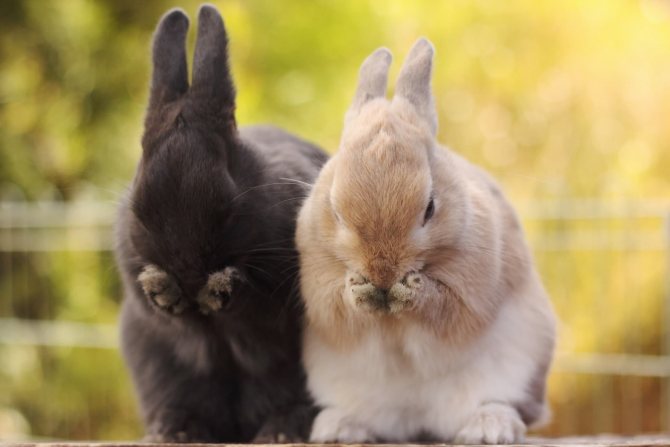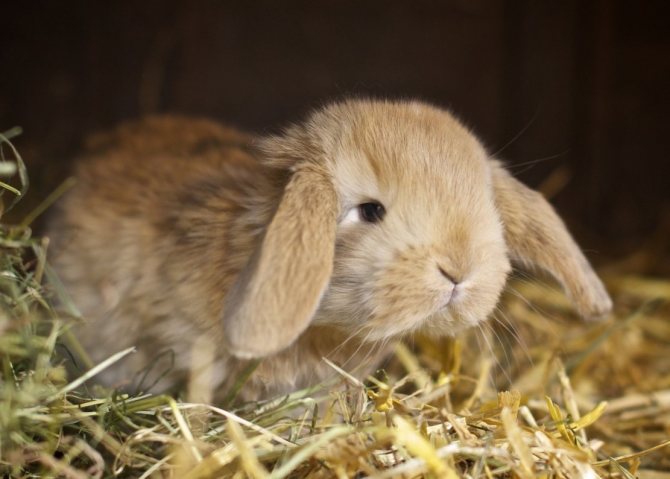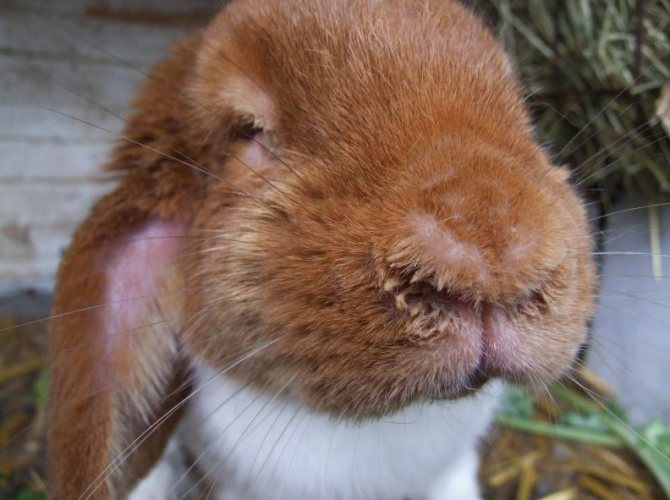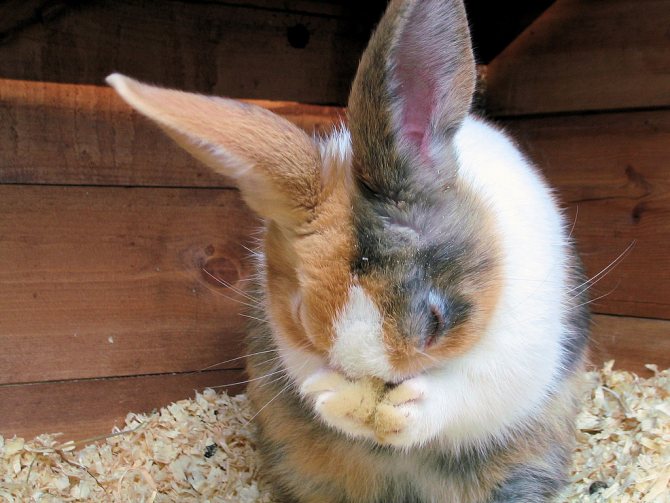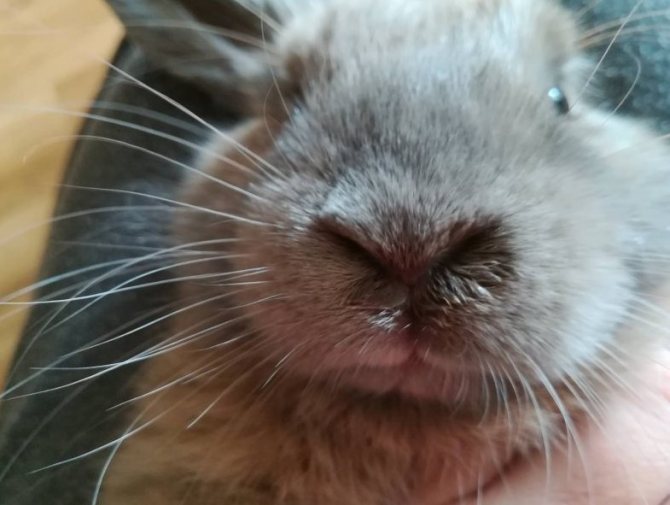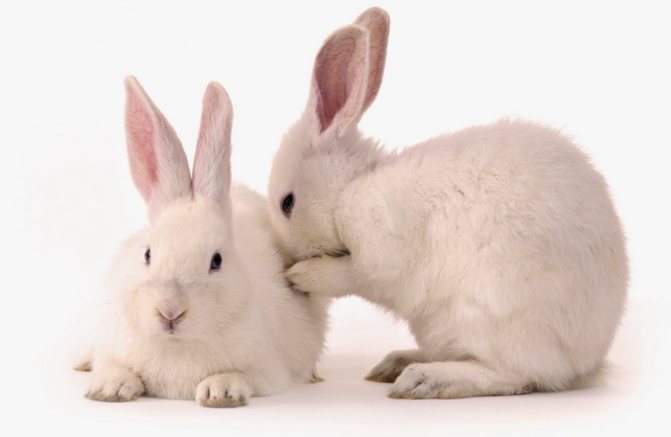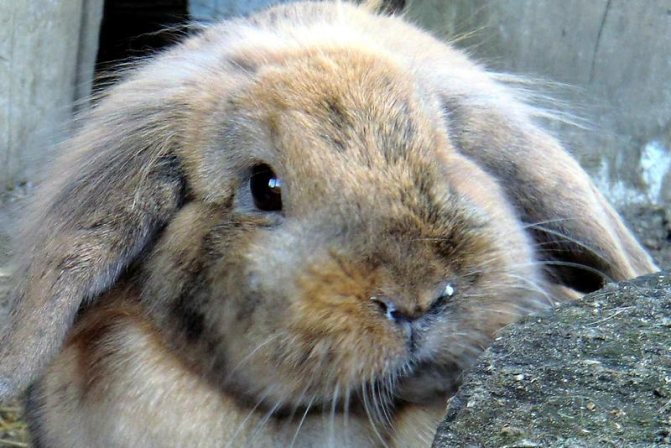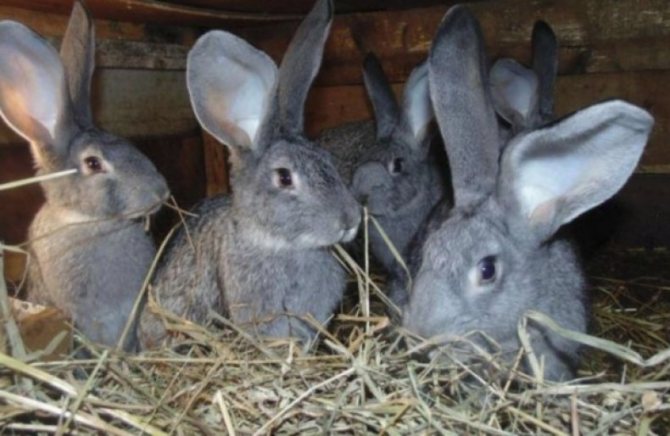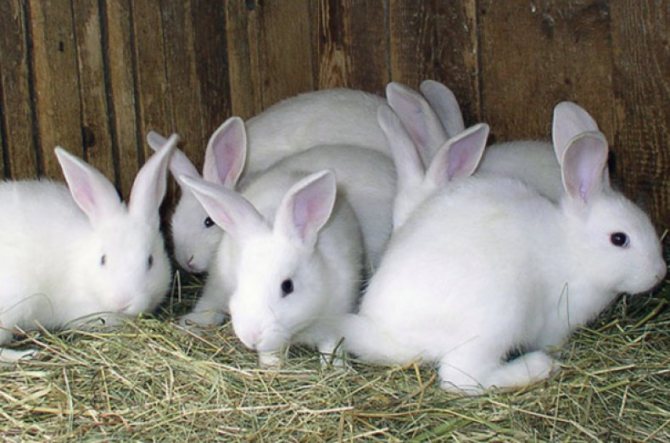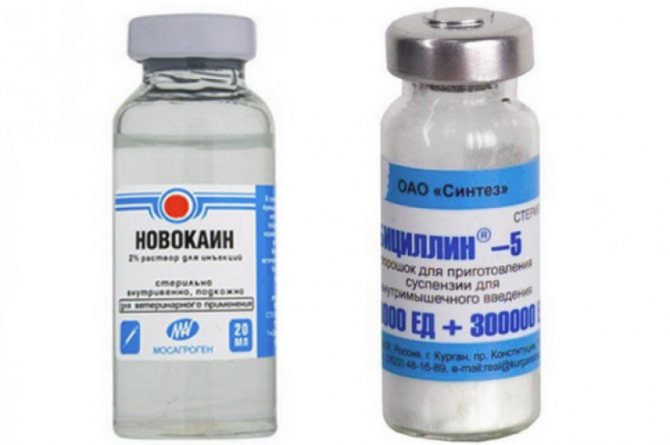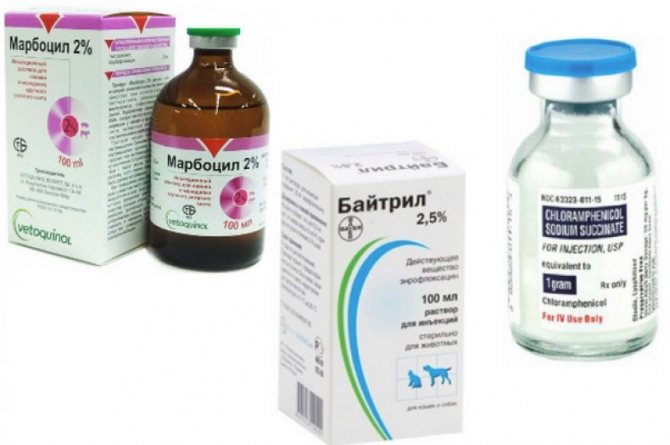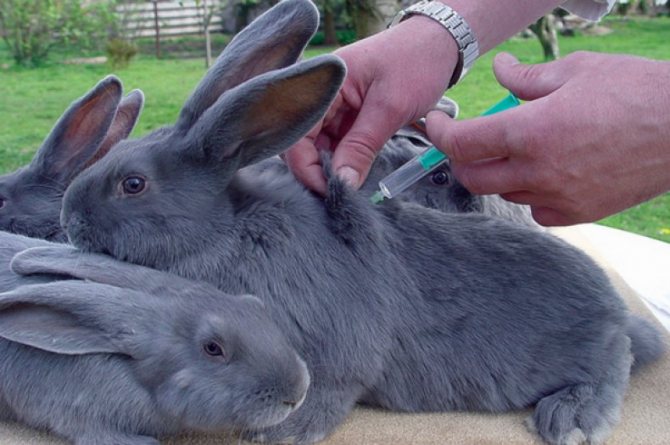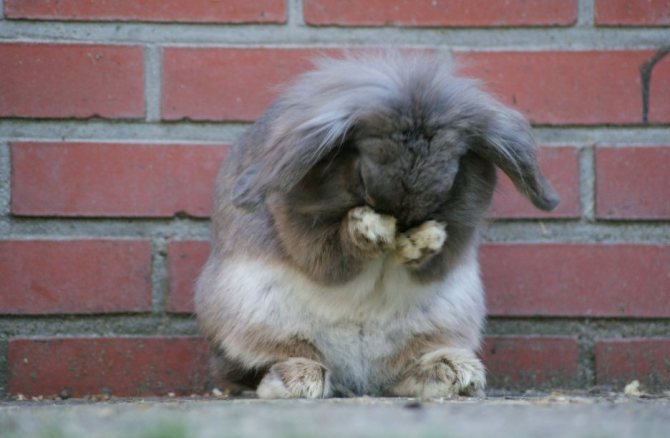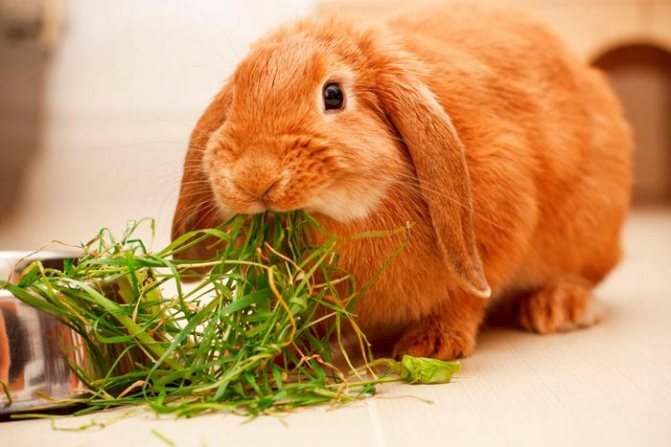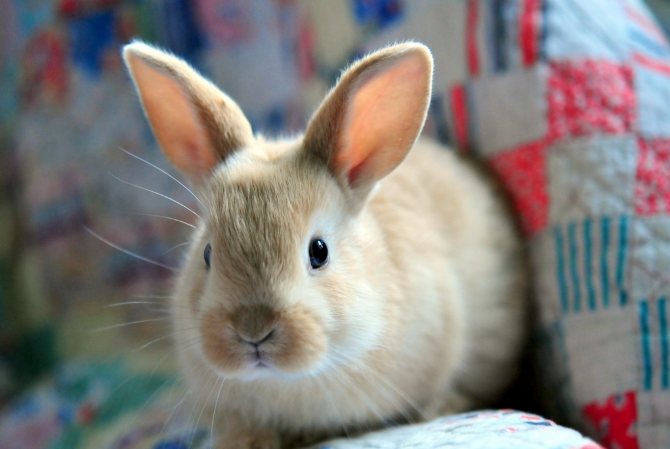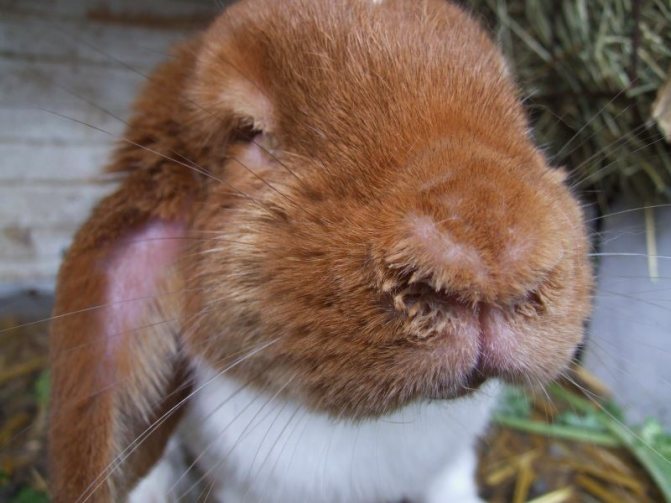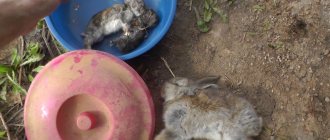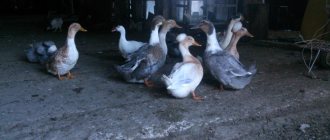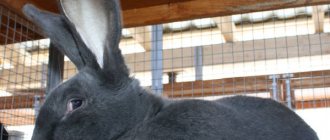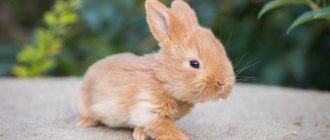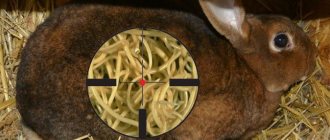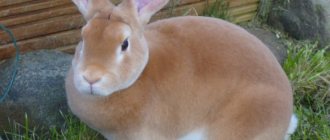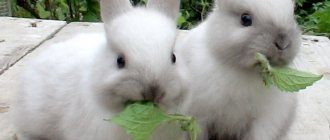Causes of sneezing in rabbits and methods of treatment
Diseases of pets are not uncommon in farming. Sometimes the rabbit sneezes and weakens dramatically. What to do and how to save the pet in this case? These are the questions that plague every farmer, both experienced and novice.
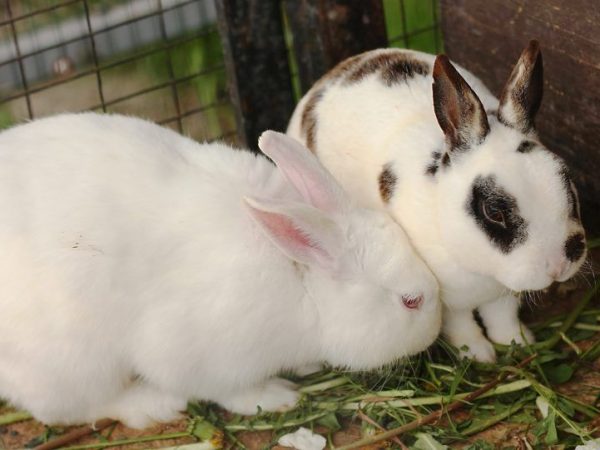
If a rabbit sneezes, symptoms similar to a cold can occur in all the inhabitants of the rabbitry. It is impossible to prevent the spread of infection, therefore, an initial examination at home and emergency assistance are the primary tasks of any farmer. Why do rabbits start sneezing?
How rhinitis develops
The first symptoms of rhinitis are noticeable after a few days. after infection. It is possible to accurately determine the presence of the disease in 5-7 days. Rhinitis can occur in different ways.
The worst case is fatal in 1.5-2 months.
Development of chronic rhinitis is also possible.... In this case, it is difficult to determine the timing of the course of the disease. Practice knows cases when infected rabbits lived up to 1.5 years, and after slaughter, the meat as a whole was suitable for human consumption.
Why is chronic rhinitis dangerous? Danger of chronic rhinitis in the fact that it can turn into pneumonia and lead to complete dysfunction of the bronchi, which leads to the death of the animal. You cannot eat the meat of such a rabbit.
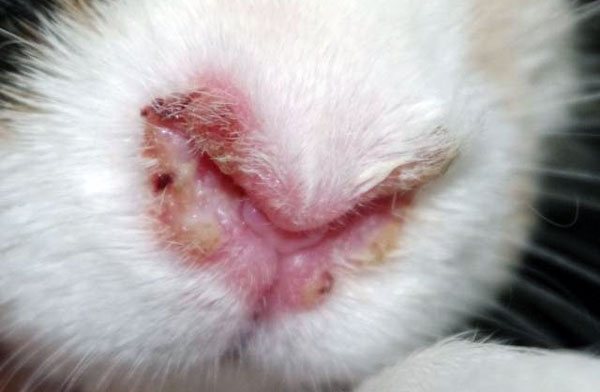

Rhinitis can kill a rabbit
Keeping rabbits at home
If the rabbit begins to sneeze, the farmer needs to inspect all the rabbits and adults.
There are only two reasons for the poor health of furry babies. Infections from which a rabbit sneezes can be transmitted from a sick pet to a healthy one, but non-infectious causes must be eliminated urgently. A sick rabbit is a threat to the entire rabbitry. You shouldn't delay calling a veterinarian. How to help a fluffy pet at home?
If several pets sneeze at once, look for the cause of the disease in a feeder or drinker. The conditions for keeping fluffy animals predetermine their well-being. Wet climates or wet cages contribute to colds that are difficult for rabbits to fight. A furry's nose becomes wet from the first days of the disease. This symptom and lethargy are the first signs of illness. The rabbit becomes quiet and eats little. Determining the primary cause of ailment in fluffy animals will help to avoid epidemics and mass death of domesticated animals.
Without a complete examination, it is difficult even for a professional to determine why a rabbit sneezes and what are the reasons for its severe weakness? If you constantly inspect the livestock that are kept in clean cages and consume high-quality feed, it is within the power of each farmer to identify the problem at the initial stages. The causes of illness in fluffy pets must be found out without fail, otherwise relapses of the disease cannot be prevented.
Folk remedies for the treatment of the common cold
Some rabbit breeders with extensive experience in treatment conduct additional courses of alternative therapy. The most popular are inhalations with sage, mint and lavender decoctions. Such procedures are carried out twice a day for a week. Inhalation is done in the following way:
- The rabbit is placed in a separate cage.
- Nearby (in a place inaccessible to the rabbit) is placed a dish with a hot broth, from which steam emanates.
- The cage with the animal is covered with a material to ensure free flow of steam into the nostrils.
Such inhalations not only improve breathing, but also contribute to the multiplication of the therapeutic effect achieved from drugs.
Why does a rabbit sneeze
Cough, wet nose are the first symptoms that a person must pay special attention to.
The rabbit sniffs and sneezes for a specific reason. If symptoms persist for a long period of time, you should not delay calling a veterinarian. Why are the rabbit and the hardy breeds sick? It is necessary to clearly define the time frame when the rabbit began to sneeze. Fluffy farm pets of this kind do not only cough for colds. Allergies that only appear during the flowering season can show similar symptoms.
Symptoms of the disease will help identify the root cause of the disease and build the right tactics for further prevention. Why does a rabbit sneeze? He suffers from diseases that occur at any time of the year:
- cold;
- allergy;
- hypothermia syndrome;
- inflammation due to injury to the nose;
- diseases associated with improper maintenance of animals;
- infections that cause cough and snot.
The nose that first responds to various colds should be examined during diagnosis. The time spent on the examination will save the individuals living in the vicinity of the patient. If there is nowhere to put a sick rabbit, it should be protected from the rest, especially from rabbits. Treatment of the disease is carried out only after determining the root cause and an accurate diagnosis. There is nothing worse for an animal than human inaction and therapy for a non-existent disease.
Sneezing rabbits can indicate improper housing conditions.
If the hare has a cold all winter, you need to insulate the cages and aviaries where the rabbits live.
The disease is not always only infectious. If the symptomatology lasts not the first day, and the infection spreads to neighboring organs: the eye, mouth and ears, it is impossible to delay treatment further. After examining the nose, ears and mouth of a fluffy pet, the veterinarian makes an accurate diagnosis and prescribes treatment. How to help a furry before a specialist arrives?
Noncommunicable diseases and treatment
If the rabbit scratches its nose and ears, sneezes, coughs, and his eyes are watering, the fluffy is sick.
To quickly alleviate the condition of the pet, it is worth considering the possible root causes of the disease. What should a novice farmer do? The presence of general symptoms, like a cold, and the presence of snot suggests that the rabbit may have an infection or as a result of severe hypothermia, the animal has suffered greatly. It is also not worth making hasty conclusions. It is necessary to make sure that the disease is not widespread.
The non-infectious nature of health problems in rabbits is mainly manifested in only two symptoms. The presence of snot and sneezing are clear signs of a cold as a result of hypothermia of the animal. It is much easier to treat individuals with a cold. Ornamental rabbit often suffers from a domesticated animal from colds. Drafts in the home where the cage is located is the most obvious cause of weakness and sneezing.
Why does a rabbit sneeze?
Sneezing and snot in a rabbit may appear for the following reasons:
- hypothermia;
- dirt and dust in the cage;
- trauma to the nose;
- infectious diseases;
- cold.
For the correct start of treatment, it is necessary to accurately establish the causes of the appearance of the pathology. In such cases, it is recommended to contact a veterinarian who will examine the animal, diagnose and prescribe treatment or medications. If it is not possible to go to a veterinarian, you can try to determine the cause of the disease yourself by a number of signs.
Important! Rhinitis in rabbits can manifest itself along with other symptoms characteristic of more dangerous diseases than colds: nasal discharge, shortness of breath, loss of appetite, depression, and ear pain.
Dust
In rabbit breeding, sneezing of rabbits is most often associated with dustiness in the place of detention, or with poor-quality (dusty) food. Dust, consisting of inorganic foreign microscopic particles, is one of the main causes of sneezing in rabbits. Dust can serve as a provocateur of more complex pathologies of the respiratory organs in rabbits (pneumonia, emphysema, pneumothorax).
The rabbit is very sensitive to dust in the air or feed
This form of sneezing is accompanied by slight reddening of the visible mucous membranes of the nose, swelling of the skin around the nose, and liquid (serous) nasal discharge. Sneezing and other things disappear soon after the restoration of sanitary and hygienic conditions of detention or feeding.
Diseases of a non-infectious nature
If the rabbit starts sneezing, it is most likely that he has a cold. The reasons for the appearance of such symptoms are a rapid change in temperature, drafts or hypothermia. In this case, it will be enough to place the animal in a warm and heated room, where there are no drafts, and a stable temperature is also kept. Non-infectious forms of pathology include allergies, which can be triggered by various allergens:
To prevent the occurrence of allergies, it is necessary to remove from the room where the rabbit is, all air fresheners, sprays, deodorants, perfumes and other substances that spread chemical odors. Also, during manifestations of allergies, it is necessary to wipe the animal's nostrils with saline.
Important! To rid the animal of allergic rhinitis, you only need to eliminate the irritant that provoked irritation of the mucous membranes of the respiratory tract, and wait 2-3 days. If, after this, the condition of the animal does not improve, you should consult a doctor.
Treatment of chronic pasteurellosis or infectious rhinitis
Infectious rhinitis (also called contagious) is caused by several types of microorganisms. The most common are Bordetella bronchiseptica and Pasteurella multocida.
The first belongs to the bordetella family - a rod-shaped, gram-negative bacterial variety. It is the cause of the infectious form of rhinitis. It is the main source of respiratory syndrome in animals such as dogs, cats, pigs and rabbits. There are reports of cases of human infection from sick rabbits and cats.
This microorganism can lead to inflammation of the bronchi. It should be noted the relationship of this microbe with the bacterium Bordetella pertussis, which leads to whooping cough.
The second species is Pasteurella multocida. It is a gram-negative microorganism of the Pasteurellaceae family. It lives in the upper respiratory tract in animals. It can serve as a source of many diseases of birds and animals.
Depending on which infection is the cause, you can determine the name and disease. If the infection that caused the discomfort is Bordetella, then the disease is called Bordetellosis, and if Pasteurella is Pasteurellosis.
Infectious diseases
What if the rabbit sneezes? First of all, in order to avoid contamination of other individuals with a possible infection, it is recommended that the sneezing rabbit be transplanted into a separate cage. If the disease was caused by an infection, the rabbit will have snot, sneeze and cough, and a number of other symptoms will appear. If the form of the disease is acute, there may be white discharge from the nose and a crust around it.
An infectious disease appears due to the effect of various viruses and bacteria on the animal:
Transplant the rabbit into a separate cage
It is worth noting that these viruses are also found in healthy animals, but at the same time they do not have a negative effect on them until optimal conditions for their development appear. In some cases, the source of the infection may be the person himself, whose disease is caused by the same bacteria.
Symptoms of infectious diseases:
- inflamed nasal mucosa;
- lacrimation;
- cough;
- discharge from the nose;
- dyspnea;
- temperature increase;
- wheezing during breathing;
- oppression.
Some of these symptoms may appear 4-5 days after the onset of the disease. If the disease is not treated, the animal may die.
Important! In case of infectious ailments, it is necessary to immediately contact veterinarians, since pathologies of a viral and bacterial nature can cause the death of the entire population of rabbits.
Symptoms of colds
Colds can be infectious or non-infectious. At the same time, general symptoms are observed, according to which you can determine the problem and take measures for treatment. Read more about the different forms of colds, pathogens and symptoms below.
Non-infectious
It is not uncommon for a rabbit to develop colds that are not infectious. Usually they are associated with the fact that the pet is cold and cold, has been exposed to a draft, was outside the house in bad and humid weather.
Often, a similar problem occurs when there are sharp changes in temperature from high to low and vice versa. In general, colds are caused by external influences.
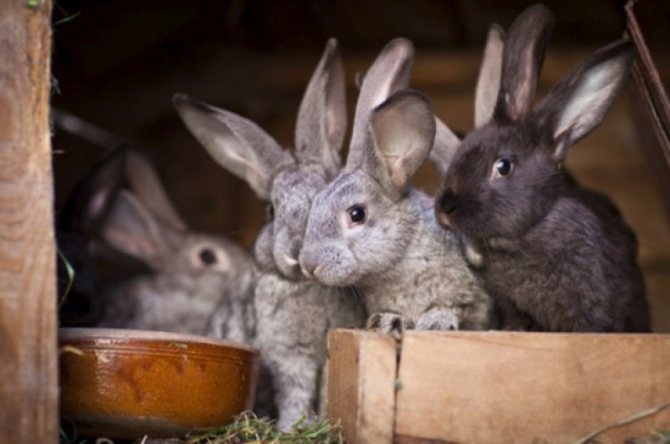

Its symptoms will be:
- frequent pet sneezing;
- rhinitis and nasal discharge, most often clear or whitish;
- a crust forms around the nose;
- sometimes there is an increase in temperature;
- there may be problems with feeding, appetite, decreased activity.
Runny nose in rabbits: how to treat and care properly
Treatment of rhinitis in rabbits should begin with a visit to the veterinarian. In addition to following the recommendations of a specialist, it is necessary to take care of a sick animal, providing it with adequate nutrition and clean drinking water.
If a rabbit has snot and sneezes, how to treat the animal? While he has not yet been examined by a veterinarian, he must be placed in a room where the animal will not be disturbed by other animals and extraneous sounds - the "patient" must be at rest. In no case should young individuals be torn away from their mother - this will aggravate the situation. Treatment of rhinitis in rabbits of adolescents and "babies" is complicated, since they have weakened immunity and they cannot cope with diseases on their own, and therefore rabbit droppings can die without the support of the mother. If at the same time the rabbit sneezes, you need to start treating her too.
The rabbit has snot
During the treatment period, feed the animals with nutritious food that contains many vitamins. It is recommended to give green herbs, cilantro and parsley, but the main food should be regular, as before. If the snotty rabbit will not eat and he continues to sneeze, then you need to offer him liquid food. It can be ordinary water, in which preparations with vitamins are diluted, or special food sold in veterinary pharmacies. Since during the illness any organism, including the rabbit, becomes dehydrated, it is necessary to replenish the water reserves in the body, therefore, it will be necessary to give the rabbit more fluid.
Prophylaxis
In order to avoid the appearance of snot, the cage must be cleaned of food debris, and excessive contamination must be avoided. It is not recommended to expose the cage with a rabbit to drafts, to allow sudden changes in temperature. Rabbit feed must be free of dust. Vaccination of rabbits against the appearance of snot is possible. The vaccination is valid for 6 months.
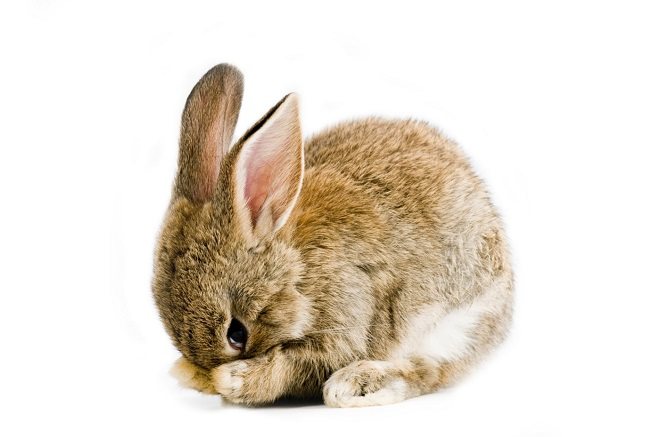

To prevent the infection from spreading, diseased individuals are isolated and even destroyed.
To prevent the spread of infection to healthy rabbits, it is recommended to slaughter the animal.This method may seem cruel, but it is effective when it comes to a large rabbit farm. In this case, the meat of a sick rabbit can be eaten. With caution, you should only treat the chest and affected organs, if any.
Preventive measures
To prevent the onset of disease in an animal, it is necessary to monitor its living conditions. It is also important to remember that rabbits are the most vulnerable animals to infections, and therefore they should always be kept clean, and there should be fresh water and warm bedding in the cage. Food must be given only of high quality and it is important to monitor the temperature in the room where the animals are. The temperature should not change dramatically. All this will help pets stay healthy throughout their entire life.
If you accept all these recommendations, fulfill them, and also correctly follow all the instructions of the doctor, then the animal can be cured, in most cases, in a short time. This will help save rabbits from extinction and will allow you to further breed these cute animals for various purposes and needs.
What to look for when buying
Be sure to pay attention to the symptoms, behavior of the rabbit before buying. Slightly treated snot does not appear in any way outwardly, but the disease can give a new wave when the animal is placed in new living conditions for it.
- Take the rabbit by the ears and withers at the same time, then turn it over with its paws up. A healthy eared man will lie quietly on his back, the patient will try to roll over, will show dissatisfaction, resistance.
- Close the nostrils of the animal alternately for no more than 1.5 minutes. If you hear whistling, wheezing, squelching, or the rabbit tries to remove its hand, it is seriously ill.
Initial examination upon purchase does not give a 100% guarantee of buying a healthy pet that has not had rhinitis before. Therefore, follow the diet and all preventive measures to prevent illness. This article will tell you about the diseases of decorative rabbits.
What to do if a rabbit sneezes and how to treat it?


Rabbit breeders know that these animals tend to get sick often, and their health needs to be taken very carefully. Any malaise should immediately alert. If your rabbit sneezes, it's important to try to find the cause right away. What to do if your pet has a runny nose and cough, readers will learn from this article. Such symptoms cannot be ignored. If we are talking about an infectious disease, the rabbit must be treated as soon as possible, otherwise it may die.
Use of slaughtered rabbits for rhinitis.
Above, I have already pointed out that rabbit rhinitis is not dangerous for people. Medical reference books show that a person's susceptibility to this type of bacteria is extremely low. There are, however, unconfirmed cases of infection from cats when scratching them. Slaughtered rabbit meat can be used as food after boiling or roasting. The exceptions are the lungs and chest.
| Subscribe to our weekly newsletters on our site: Current notes on the content of rabbits are waiting for you. SUBSCRIBE |
They are best separated and disposed of. But if you give up this pleasure, it will probably be even better. I personally don't eat rhinitis rabbits. As for the skins and down, they can be used without restrictions after being removed and dried. Dry only in separate, isolated areas. Dried skins are recommended to take out for 10-15 minutes in the sun. During this time, all bacteria will die. Adherents of salting skins in barrels are advised not to risk it. It is known that medical saline (NaCl) is not an antiseptic.
Causes of cough
Cough and runny nose usually accompany each other, and the reasons that caused these symptoms are often:
- Hypothermia.
- Allergy to dust in the cell, to chemicals.
- Respiratory infections.
- Injury to the animal's nose (there is no cough, but the animal sneezes).
Having discovered that the pet has a runny nose, and sometimes together with a cough, it is important to figure out whether an infection is related to the malaise. If possible, it is better to show the animal to the veterinarian.
Infectious colds
If the rabbit sneezes, you should pay attention to her general condition. When a virus is introduced into the body of an animal or a bacterial infection enters, this can be determined by the accompanying symptoms:
Rabbit with an infectious cold
- The pet loses its appetite.
- He is depressed, weakened.
- The coat becomes dull and slick.
- The body temperature rises.
- Lacrimation is observed.
- A mucous or purulent secretion is secreted from the nose.
- Shortness of breath, wheezing, coughing may occur.
Important! If at least one of the listed symptoms is found, it is urgent to separate the sick individual from healthy rabbits. Otherwise, the infection will affect all pets.
Types of rhinitis
Attention! With infectious rhinitis, the pet's state is depressed, it loses its appetite, its coat loses its shine, breathing becomes difficult, and an increase in temperature is often observed.
Treatment methods
After detecting signs of infection in a pet, treatment should be started as soon as possible. Medication is the best choice. Self-medication is not worth it when it comes to the viral or bacterial origin of the disease. Wrongly chosen means and methods of therapy can be ineffective. It is advisable to contact the veterinary service for diagnosis and treatment.
If there are no signs of infection, the rabbit should be placed in a warm place. In the room where it is contained, you cannot use chemical agents in the form of sprays, aerosols, and you cannot smoke there. If allergies are the cause of a runny nose and sneezing, these measures should help improve the condition of the pet. Mucous discharge and crusts around the nose should be wiped off with a cotton swab dipped in hydrogen peroxide solution or saline. With non-infectious rhinitis, a good result is achieved after instilling the pet's nose with a furacilin solution.
Drugs
For the treatment of rhinitis of an infectious origin, broad-spectrum antibiotics are used, since the disease can be caused by various bacteria. We enclose a list of drugs for your reference:
- Marbocil (2%) at a dosage of 0.1 ml per kg of body weight.
- Veracin-comp, dose 0.1 ml / kg.
- Chloramphenicol (2 to 5 mg / kg).
- Baytril - 0.3 ml / kg.
- Biomycin.
- Oxytetracycline.
Antibiotics are administered intramuscularly according to the scheme recommended by the veterinarian. The duration of the course is also determined by the doctor. The same drugs are often used to instill the nasal passages of an animal, however, this does not replace their intramuscular administration.
Attention! Veracin-Comp is ineffective against Staphylococcus aureus. If the causative agent of the disease is unknown, it is better to use other antibacterial drugs.
In parallel with antibiotics, pets are given probiotics to normalize the intestinal microflora.
Inhalation
If the rabbit has a runny nose, cough, sneezing - inhalations will help soothe the mucous membrane of the nose and throat and clear mucus from the respiratory tract. However, this procedure does not preclude antibiotic treatment.
Fennel essential oil
For inhalation, herbal decoctions or essential oils are used:
If a concentrated essential oil is used, then add 1 drop of the product to 2 liters of water.Make sure for yourself that the solution does not irritate the throat when the vapor is inhaled. Procedure rules:
- Put hay in the pet's cage and place a drinker with clean water.
- Brew the raw materials, let it brew and cool slightly.
- Place a container with herbal decoction next to the cage (make sure your pet cannot turn it over).
- Cover the cage with a towel, leaving a small gap for air to circulate.
- The duration of each procedure is no more than 5-7 minutes.
- After inhalation, remove mucus from your pet's nose with a clean cloth or tissue.
Attention! The course of treatment by inhalation should not exceed 6-7 days. Frequent inhalation of vapors can dry out the mucous membranes of the nose and throat. Ideally, procedures should be completed with antibiotics.
What to do?
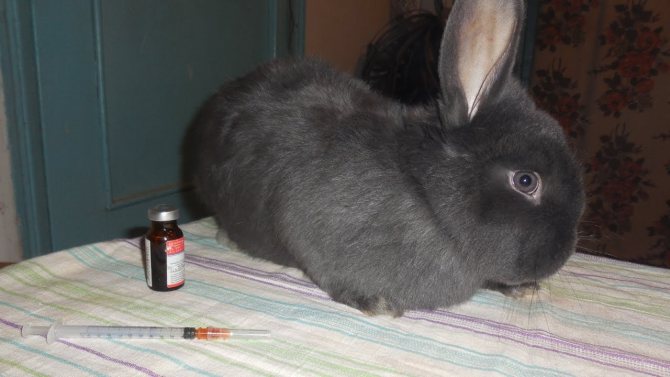

Treatment of infectious colds requires a competent selection of medicines. For example, viral infections are not recommended to be treated with antibiotics because they can do more harm than good.
If it is a simple cold, then it is enough to place the animal in a warm room, improve nutrition, add nutrients to the feed.
In the case when the pet does not get better, drug treatment should be carried out.
You will learn about what drugs are needed and what treatment regimen to follow.
Medication
Furacilin, Penicillin and antibiotics in combination with probiotics are often used to treat an animal.
Treatment is necessarily carried out in courses and requires careful adherence to instructions.
A mixture of Penicillin and Novocaine
If after three days the rabbit does not stop sneezing, its mucous membrane swells, a runny nose becomes constant, a fever and other symptoms are observed, then a mixture of drugs such as Penicillin and Novocaine can be used.
Penicillin in the ratio of 20 thousand units. is diluted in 1 ml of Novocaine 0.25%. The resulting medicine is gently injected into each nostril with a pipette. The course of treatment is at least two weeks.
In total, 10 drops should be dripped a day, 2-3 times (one or two drops in each nostril, respectively). Such a mixture not only helps to destroy the infection, but also relieve swelling, pain and irritation.
Furacilin
Furacilin has long been used to treat not only humans, but also animals. The tablet is thoroughly crushed and diluted in water in a ratio of 1: 100 (1 g per 100 ml).
Water must be taken hot and freshly boiled, mix thoroughly. After the solution has cooled, it is pipetted into the nostrils.
Use the same system as in the previous case: 10 drops per day for two weeks. The drug helps to disinfect mucous membranes, removes infection, relieves irritation. The solution works in 70% of cases.
Antibiotics


In some cases, antibiotics become necessary. The most commonly used are Chloramphenicol, Marbocil 2% and Baytril 2.5% - very strong and effective antibiotics.
Marbocil is injected twice a day, 0.1 mg of the drug per 1 kg of animal weight (it should be administered according to the instructions and only after consulting a doctor who can adjust or change the dosage).
Baytril is administered according to the same scheme, but at the rate of 0.3 mg per 1 kg of animal weight. Can be given as an injection or added to food. Chloramphenicol is given 30-50 g twice or three times a day, adding to food.
Important! Before starting treatment for your pet, you need to contact your veterinarian for advice. He will be able to correctly prescribe the necessary drugs and their dosage. If necessary, he will also prescribe tests, since rhinitis can indicate other diseases.
For the treatment of infection, you can also give 1 mg of Biomycin per day, diluting it in warm water and adding it to food. In case of serious illness, the dose is increased to 3 mg and given three times a day.
The drug acts quickly.
Usually, positive results are observed as early as day 5. After using antibiotics, it is recommended to take a course of probiotic treatment.
They help the body restore its functions, cope with the damage caused by the antibiotic to the intestines, and even prevent the return of the disease again.
For this, vitamin B is used (given once or twice a day, 1 mg), Sulfadimethoxin (100 mg per day, added to food), Norsulfazole (200-250 g per day).
The course of preventive treatment lasts 5-10 days. Do not use large dosages, it is better to give the minimum dosage.
Inhalation
A good method of treating rabbits is inhalation using natural herbs or essential oils. They use fennel, thyme, sage, eucalyptus and mint. The proportion should be observed: 1 drop of oil in 2 liters of water.
This method of treatment helps to clear the nose and has a good effect on the condition of the respiratory tract. Inhalations can be carried out once or twice a day, but not longer than a week, so as not to dry out the mucous membrane.
A vessel with a hot solution is placed at a distance from the animal so that it does not reach it, after which the cage and dishes are covered with a towel, leaving an open edge for air to enter.
The duration of the procedure is 10-15 minutes. At this time, the pet freely breathes in vapors of plants or ether, which help him get rid of coughs and runny nose.
Care and nutrition during illness
A weakened pet needs quality care. It should be kept warm, in a draft-free room. However, fresh air is needed. If the room is cool, it makes sense to put a heating pad in the cage.
Animal nutrition is what you should pay special attention to. During the period of illness, vitamins must be present in the diet. In the summer, you can increase the proportion of succulent food, which contains many useful substances. Include dill, chamomile, basil, and mint on your menu.
Chamomile in the diet of a sick rabbit
What to feed during the illness?
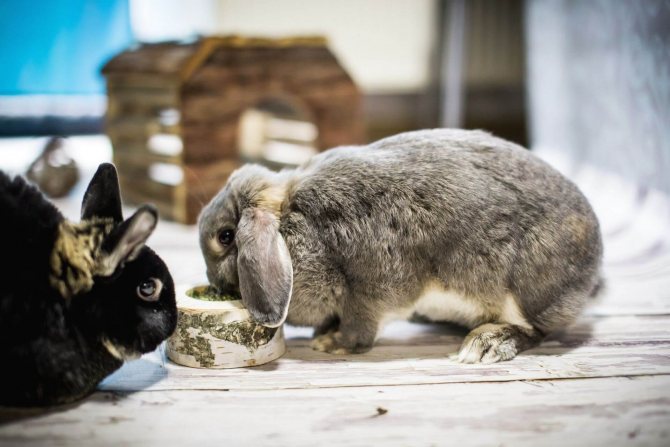

There are no special indications that the patient should have a diet.
You should not limit food, on the contrary, it is better to add more nutrients, vitamins, greens.
Fruit and vegetables are also added to the diet.
You also need to make sure that the food is warm. During illness, the rabbit needs increased heat, so it needs to be moved to the warmest place in the house and fed there.
Rabbits can also be fed herbal teas as a drink. Mint, basil, dill, or chamomile are used.
They not only warm (they are given warm) and quench thirst, but also support the immune system, allow you to receive an additional portion of nutrients.
It is imperative to make sure that the rabbit feeds during illness, as it may refuse food. In case of prolonged refusal, he should be force-fed.

